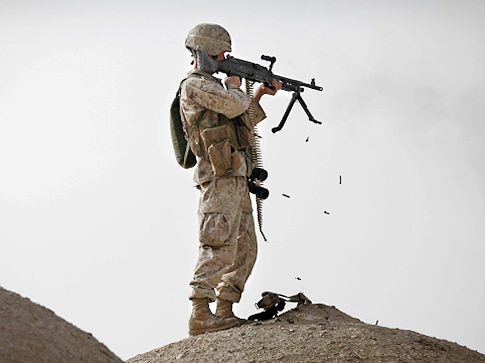 Writing in The Washington Post, Rajiv Chandrasekaran offers the latest article proclaiming progress in the US military campaign in southern Afghanistan.
Writing in The Washington Post, Rajiv Chandrasekaran offers the latest article proclaiming progress in the US military campaign in southern Afghanistan.
To be fair, this is more than the common cheerleading piece for American commanders. Chandresekaran cautions that there might be a violent summer in the south and, even more interesting, refers in the middle of the story to "deterioration of security in eastern Afghanistan" and the belief of some US military and diplomats that "the transformation [to Afghan security forces is] unsustainable".
All of this raises the question as to whether the US military are carrying out a high-wire PR balancing act --- we're winning, but to keep on winning, we have to stay far beyond President Obama's proposed withdrawal beginning in July.
Signs of change have sprouted this spring amid the lush fields and mud-brick villages of southern Afghanistan.
In Sangin, a riverine area that has been the deadliest part of the country for coalition troops, a journey between two bases that used to take eight hours because of scores of roadside bombs can now be completed in 18 minutes.
In Zhari district, a once-impenetrable insurgent redoubt on the western outskirts of Kandahar city, residents benefiting from U.S.-funded jobs recently hurled a volley of stones at Taliban henchmen who sought to threaten them.
And in Arghandab district, a fertile valley on Kandahar’s northern fringe where dozens of U.S. soldiers have been felled by homemade mines, three gray-bearded village elders made a poignant appearance at a memorial service last month for an Army staff sergeant killed by one of those devices.
Those indications of progress are among a mosaic of developments that point to a profound shift across a swath of Afghanistan that has been the focus of the American-led military campaign: For the first time since the war began nearly a decade ago, the Taliban is commencing a summer fighting season with less control and influence of territory in the south than it had the previous year.
“We start this year in a very different place from last year,” Gen. David H. Petraeus, the top coalition commander in Afghanistan, said in a recent interview.
The security improvements have been the result of intense fighting and the use of high-impact weapons systems not normally associated with the protect-the-population counterinsurgency mission.
In Sangin, Zhari and Arghandab — the three most insurgent-ridden districts in the south — the cost in American lives and limbs since the summer has been far greater than in any other part of the country. More than 40 Marines have been killed in Sangin in the past nine months, and three dozen more have lost both legs. The Army brigade responsible for Zhari and part of Arghandab has lost 63 soldiers since July.
The question of the moment for Petraeus and his subordinates is whether the gains will hold as Taliban commanders, laden with cash and munitions, stream across the desert from Pakistan, where there has been considerably less progress in denying them sanctuary.
Senior U.S. officers said they expect the insurgents to shift tactics: Instead of trying to take on American troops directly, as they did in Sangin and Zhari in the fall, the Taliban will attempt to plant more homemade explosives, recruit a new cadre of suicide bombers and assassinate Afghan government officials — as it did late last week, killing the police chief in Kandahar province. The result, according to an internal military projection, could be a far more violent summer for both Americans and Afghans.
Petraeus and other U.S. commanders say they are hopeful that Afghan civilians will feel confident enough to report Taliban activity to U.S. or Afghan troops. They also are optimistic that improvements in the quality of the Afghan army and of U.S. battlefield intelligence will provide a significant boost to counterinsurgency efforts.
For now, however, President Obama, who has pledged to begin pulling out troops in July, faces a complex and risky challenge. Within the next three months, he must decide whether the tenuous but promising changes in southern Afghanistan merit a significant reduction of forces or a more token drawdown.
That calculus also will be complicated by a deterioration of security in eastern Afghanistan. Because senior officers had long assumed the east was more secure than the south, the bulk of the surge forces were sent southward to Helmand and Kandahar provinces. Now some of those officers are hoping to shift more troops east if the improvements in the south hold.
Petraeus has not provided his withdrawal recommendation to Obama. The four-star general said the progress across southern Afghanistan remains “fragile and reversible,” although he also has made it clear to his subordinates that he thinks it can be cemented with enough time and military pressure.
Other U.S. military officials and some diplomats regard the transformation as unsustainable. They doubt Afghan government officials, police officers and soldiers will be able to take control of cleared areas by 2014, the year by which the United States and its NATO allies have pledged to cede responsibility for security to the Afghans.
“It’s great that the Taliban has been pushed out of these areas, but then what?” said a senior U.S. official involved in Afghanistan policy who was not authorized to speak on the record. “Once we leave these places, it’s hard to imagine that the Afghans will really be able to hold on to them.”